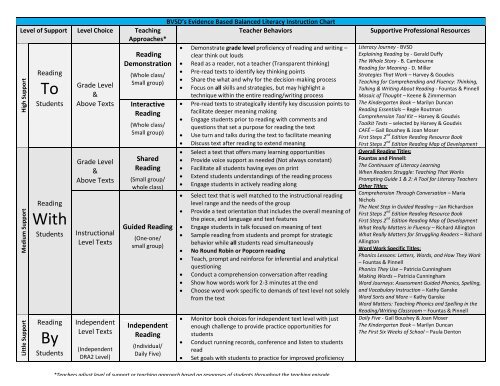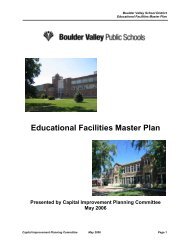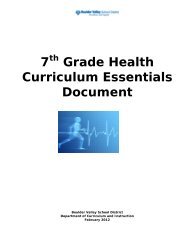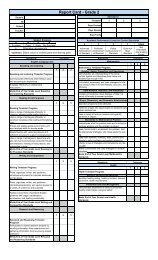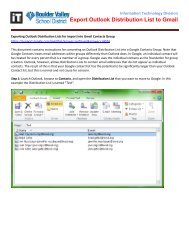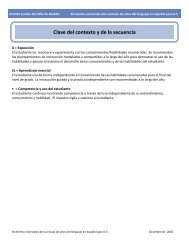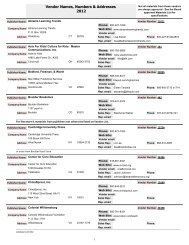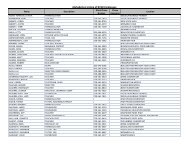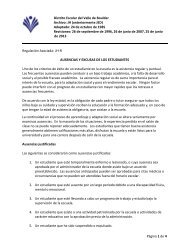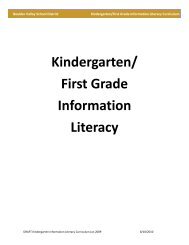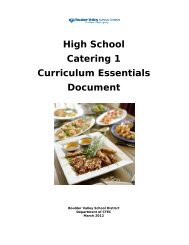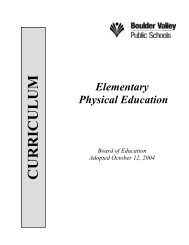You also want an ePaper? Increase the reach of your titles
YUMPU automatically turns print PDFs into web optimized ePapers that Google loves.
Little <strong>Support</strong><br />
Medium <strong>Support</strong><br />
High <strong>Support</strong><br />
<strong>BVSD</strong>’s Evidence Based Balanced <strong>Literacy</strong> Instruction Chart<br />
Level of <strong>Support</strong> Level Choice Teaching<br />
Teacher Behaviors<br />
Approaches*<br />
Reading<br />
Demonstrate grade level proficiency of reading and writing –<br />
clear think out louds<br />
Demonstration Read as a reader, not a teacher (Transparent thinking)<br />
Reading<br />
Pre-read texts to identify key thinking points<br />
(Whole class/<br />
Share the what and why for the decision-making process<br />
Grade Level<br />
Small group)<br />
Focus on all skills and strategies, but may highlight a<br />
To &<br />
technique within the entire reading/writing process<br />
Students Above Texts Interactive Pre-read texts to strategically identify key discussion points to<br />
Reading<br />
facilitate deeper meaning making<br />
Engage students prior to reading with comments and<br />
(Whole class/ questions that set a purpose for reading the text<br />
Small group)<br />
Use turn and talks during the text to facilitate meaning<br />
Discuss text after reading to extend meaning<br />
Select a text that offers many learning opportunities<br />
Grade Level<br />
Shared Provide voice support as needed (Not always constant)<br />
&<br />
Reading Facilitate all students having eyes on print<br />
Extend students understandings of the reading process<br />
Above Texts (Small group/<br />
whole class)<br />
Engage students in actively reading along<br />
Select text that is well matched to the instructional reading<br />
Reading<br />
level range and the needs of the group<br />
Provide a text orientation that includes the overall meaning of<br />
the piece, and language and text features<br />
With<br />
Guided Reading Engage students in talk focused on meaning of text<br />
Students Instructional<br />
Sample reading from students and prompt for strategic<br />
(One-one/<br />
Level Texts<br />
behavior while all students read simultaneously<br />
small group)<br />
No Round Robin or Popcorn reading<br />
Teach, prompt and reinforce for inferential and analytical<br />
questioning<br />
Conduct a comprehension conversation after reading<br />
Show how words work for 2-3 minutes at the end<br />
Choose word work specific to demands of text level not solely<br />
from the text<br />
Reading<br />
By<br />
Students<br />
Independent<br />
Level Texts<br />
(Independent<br />
DRA2 Level)<br />
Independent<br />
Reading<br />
(Individual/<br />
Daily Five)<br />
<br />
<br />
<br />
Monitor book choices for independent text level with just<br />
enough challenge to provide practice opportunities for<br />
students<br />
Conduct running records, conference and listen to students<br />
read<br />
Set goals with students to practice for improved proficiency<br />
<strong>Support</strong>ive Professional Resources<br />
<strong>Literacy</strong> Journey - <strong>BVSD</strong><br />
Explaining Reading by - Gerald Duffy<br />
The Whole Story - B. Cambourne<br />
Reading for Meaning - D. Miller<br />
Strategies That Work – Harvey & Goudvis<br />
Teaching for Comprehending and Fluency: Thinking,<br />
Talking & Writing About Reading - Fountas & Pinnell<br />
Mosaic of Thought – Keene & Zimmerman<br />
The Kindergarten Book – Marilyn Duncan<br />
Reading Essentials – Regie Routman<br />
Comprehension Tool Kit – Harvey & Goudvis<br />
Toolkit Texts – selected by Harvey & Goudvis<br />
CAFÉ – Gail Boushey & Joan Moser<br />
First Steps 2 nd Edition Reading Resource Book<br />
First Steps 2 nd Edition Reading Map of Development<br />
Overall Reading Titles:<br />
Fountas and Pinnell:<br />
The Continuum of <strong>Literacy</strong> Learning<br />
When Readers Struggle: Teaching That Works<br />
Prompting Guide 1 & 2: A Tool for <strong>Literacy</strong> Teachers<br />
Other Titles:<br />
Comprehension Through Conversation – Maria<br />
Nichols<br />
The Next Step in Guided Reading – Jan Richardson<br />
First Steps 2 nd Edition Reading Resource Book<br />
First Steps 2 nd Edition Reading Map of Development<br />
What Really Matters in Fluency – Richard Allington<br />
What Really Matters for Struggling Readers – Richard<br />
Allington<br />
Word Work Specific Titles:<br />
Phonics Lessons: Letters, Words, and How They Work<br />
– Fountas & Pinnell<br />
Phonics They Use – Patricia Cunningham<br />
Making Words – Patricia Cunningham<br />
Word Journeys: Assessment Guided Phonics, Spelling,<br />
and Vocabulary Instruction – Kathy Ganske<br />
Word Sorts and More – Kathy Ganske<br />
Word Matters: Teaching Phonics and Spelling in the<br />
Reading/Writing Classroom – Fountas & Pinnell<br />
Daily Five - Gail Boushey & Joan Moser<br />
The Kindergarten Book – Marilyn Duncan<br />
The First Six Weeks of School – Paula Denton<br />
*Teachers adjust level of support or teaching approach based on responses of students throughout the teaching episode.
Little <strong>Support</strong><br />
Medium <strong>Support</strong><br />
High <strong>Support</strong><br />
Level of <strong>Support</strong> Level Choice Teaching<br />
Approaches*<br />
Writing<br />
To<br />
Students<br />
Writing<br />
With<br />
Students<br />
Writing<br />
By<br />
Students<br />
Grade Level<br />
&<br />
Above Texts<br />
Grade Level<br />
&<br />
Above Texts<br />
Instructional<br />
Level Texts<br />
Independent<br />
Level Texts<br />
Writing<br />
Demonstration<br />
(Whole class/<br />
Small group)<br />
Community<br />
Writing:<br />
Shared/<br />
Interactive<br />
Writing<br />
(Small group/<br />
whole class)<br />
Guided Writing<br />
(One-one/<br />
small group)<br />
Independent<br />
Writing<br />
(Individual/<br />
Daily Five)<br />
<strong>BVSD</strong>’s Evidence Based Balanced <strong>Literacy</strong> Instruction Chart<br />
Teacher Behaviors<br />
<br />
<br />
<br />
<br />
<br />
<br />
<br />
<br />
<br />
<br />
<br />
<br />
<br />
<br />
<br />
<br />
Demonstrate grade level proficiency of writing – clear think<br />
out louds (Teacher’s message – not students’)<br />
Write as a writer, not a teacher (Transparent thinking)<br />
Share the what and the why for the decision-making process<br />
Plan for entry points from the most struggling to the most<br />
proficient level learners<br />
Focus on all skills and strategies but may highlight a technique<br />
within the entire writing process (Planning through publishing)<br />
Serve as a scribe for the construction of the text<br />
Interactive only: Share the pen with students during key<br />
teaching points surrounding letters, parts of words or<br />
complete words<br />
Lead a group composition of the text (Shared Message)<br />
Serve as a medium while navigating the entire writing process<br />
including publishing, and sharing with intended audiences<br />
Clarify the message of the text and support its organization<br />
Reread the text frequently during its construction<br />
o Model meaning making and revision<br />
o Create another text for independent reading<br />
Add text to classroom library or post it as a resource<br />
Organize groups to provide intentional support based on the<br />
ongoing evaluation of daily student writing<br />
Provide explicit instruction in a particular area of writing<br />
o Proofreading, revision, planning, spelling, etc<br />
Use a teach, prompt and reinforce method to promote<br />
students doing most of the learning work and foster<br />
independence<br />
Assess by observing, asking questions and taking notes<br />
Note: Dictated writing is a form of guided writing in which the<br />
teacher supports student writing with tools such as Elkonin Boxes.<br />
This format is supportive for oral language development, solving<br />
words in context and checking their work<br />
<br />
<br />
<br />
<br />
Set goals with students to practice to improve proficiency<br />
Provide practice sorts that have been taught<br />
Allow for work on assigned or free choice pieces<br />
Promote students working through the entire writing process<br />
including publishing and sharing with intended audiences<br />
<strong>Support</strong>ive Professional Resources<br />
<strong>Literacy</strong> Journey - <strong>BVSD</strong><br />
The Continuum of <strong>Literacy</strong> Learning - Fountas &<br />
Pinnell<br />
The Whole Story- B. Cambourne<br />
Writing Instruction K-6 – Jan Turbill & Wendy Bean<br />
Craft Lessons: Teaching Writing K-8 – Ralph Fletcher<br />
Writing Essentials – Regie Routman<br />
First Steps 2 nd Edition Writing Resource Book<br />
First Steps 2 nd Edition Writing Map of Development<br />
Overall Writing Titles:<br />
Fountas and Pinnell:<br />
The Continuum of <strong>Literacy</strong> Learning<br />
When Readers Struggle: Teaching That Works<br />
Prompting Guide 1 & 2: A Tool for <strong>Literacy</strong> Teachers<br />
Other Authors:<br />
Writing Instruction K-6 – Jan Turbill & Wendy Bean<br />
Interactive Writing: How Language and <strong>Literacy</strong> Come<br />
Together, K-2 – McCarrier & Pinnell<br />
Units of Study for Primary Writing – Lucy Calkins<br />
Craft Lessons: Teaching Writing K-8 – Ralph Fletcher<br />
What a Writer Needs – Ralph Fletcher<br />
Writing Workshop: The Essential Guide – R. Fletcher<br />
The Writing Workshop – Katie Wood Ray<br />
Writing Essentials – Regie Routman<br />
First Steps 2 nd Edition Writing Resource Book<br />
First Steps 2 nd Edition Writing Map of Development<br />
A Fresh Look at Writing – Donald Graves<br />
Word Work Specific Titles:<br />
Fountas and Pinnell:<br />
Word Matters<br />
Phonics Lessons: Letters, Words, and How They Work<br />
Other Authors:<br />
Breaking the Code- Richard Gentry<br />
The Science of Spelling – Richard Gentry<br />
Phonics They Use – Patricia Cunningham<br />
Making Words – Patricia Cunningham<br />
Word Journeys – Kathy Ganske<br />
Word Sorts and More – Kathy Ganske<br />
Daily Five - Gail Boushey & Joan Moser<br />
The Kindergarten Book – Marilyn Duncan<br />
The First Six Weeks of School – Paula Denton<br />
*Teachers adjust level of support or teaching approach based on responses of students throughout the teaching episode.<br />
District adopted resources, Being a Writer, Words Their Way, Sitton Spelling, also serve to support <strong>BVSD</strong>’s Evidence Based Instruction.


